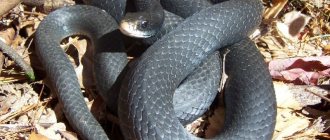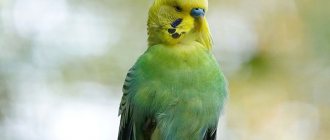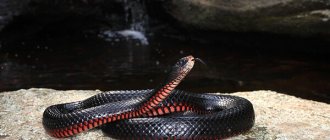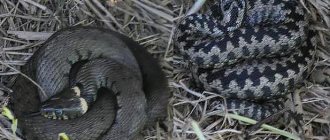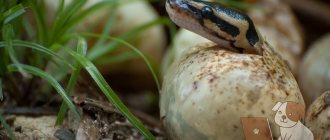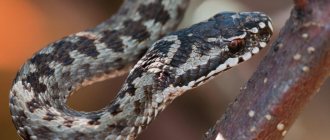In recent years, in the Moscow region, cases of people encountering snakes have become more frequent, although previously these animals could be found mainly on the banks of reservoirs, wetlands and forests. Cases of snakes entering the summer cottages of residents of the Moscow region have become more frequent. We decided to figure out where so many snakes came from, how dangerous they are, and what to do if you encounter a snake on your property.
The main reason for the increase in snakes is the lack of control over their population. Since the closure of the Moscow Serpentarium in 1996, control over reptiles by scientists has completely ceased, and the extraction of snake venom for medical purposes has been stopped.
For example, during the Soviet era, Moscow serpentologists caught about 12,000 snakes annually, but now no one does this.
Another reason is that to protect the strong forest fires that raged the area several years ago, a procedure was carried out to water the peat bogs, which created a favorable environment for the living and breeding of reptiles.
As a result, a large number of reptiles live in wetlands and come to our garden plots.
What snakes live in the Moscow region
There are only three species of snakes in the region. One poisonous common viper, and two non-venomous vipers, a common copperhead and a common copperhead.
Let's look at each of them.
Common viper
The common viper is the only poisonous species of reptile in the Moscow region.
A small snake, the body length rarely exceeds 65 cm, it is very often black in color, but sometimes gray specimens are found.
A viper bite is potentially dangerous to humans, but in good health and a strong body, it is rarely fatal if prompt medical attention is provided.
It can definitely be dangerous in the presence of allergic reactions, unfortunately, most people do not know about them and will not find out until the bite; in this situation, everything can end critically, even in death, if medical assistance is not immediately provided.
When bitten, quite serious consequences arise in the form of severe swelling, dizziness, shock, and disruption of the functioning of internal organs.
Basic help: call an ambulance and inform the doctor that you have been bitten by a viper; the victim must be laid down and given fluids.
It is forbidden to apply tourniquets to the affected surface, cauterize or cut the wound.
Rehabilitation in hospital can take from 10 to 30 days.
Many eyewitnesses who had an encounter with a viper could notice that it very rarely crawls away.
It has not been scientifically proven, but the rationale for this phenomenon is as follows:
The viper has no hearing; instead, it feels all the vibrations and vibrations with its entire body that come from the ground, so when a person moves on soft ground, there are practically no vibrations, and the probability of getting close enough to the viper is very high.
This may explain the sudden encounters with a snake and the bites that may occur, as it will defend itself.
In this regard, in places where vipers are likely to appear, you should be careful and attentive. In such places you should not walk in open shoes and without thick clothing on your feet.
Listed in the Red Book.
Already ordinary
Quite a frequent inhabitant of garden plots. Non-venomous, cautious, always tries to run away when meeting a person. It is quite easy to distinguish from other snakes thanks to the bright yellow markings on the head.
It has quite interesting methods of defense: if you catch it, it begins to wriggle sharply, hiss and inflate, if this does not help, it pretends to be dead and secretes a stinking liquid from its glands. It may sometimes bite, but the bite is not poisonous. It is easily tamed and kept in captivity.
Common snake, Photo: Pixabay/Erik_Karits
Common copperhead
Like snakes, it belongs to the same family of colubrids. Not poisonous and not dangerous to humans. It has a body no more than 70 cm long.
Just like the snake, when meeting a person, it tries to quickly leave the meeting place; it can bite in defense; the bite is not dangerous, except for two punctures in the skin.
Likewise, it can defend itself, and it does so quite aggressively, curling up into a ball and throwing itself towards the threat, and similarly secretes a stinking liquid.
In many regions of Russia and around the world, the species is included in the Red Book, and catching and destruction is prohibited.
If a viper bites me, will I die?
After a bite, the situation can develop in two scenarios:
- anaphylactic shock (a person loses consciousness, has difficulty breathing, and cardiac activity is disrupted) and may die.
- local reaction (inflammation).
On average, toxins spread within 20-25 minutes, after which the first signs of poisoning appear. And the sooner you get help after a snake bite, the faster you administer the antidote, the fewer bad consequences there will be (shock, swelling, failure of internal organs, severe dizziness), and the lower the likelihood of death. In 70% of cases, after administration of the antidote, all symptoms disappear 3-5 days after the bite, but sometimes hospital rehabilitation from 10 days to a month is required. The worst thing is if the viper bites in the upper part of the body - this is how the main dose of toxins enters the head and affects the brain.
What to do when meeting a snake
Nothing, just pick it up and move away without making any sudden movements, then the animal itself will leave the place where you met her. You should not try to kill her or tease her, if you do not have experience in handling snakes, she will be faster than you.
If it has started up on your site, then you can call a specialist to catch it and resettle it; in the Russian Federation there is such a service (the cost of the service is about 3,000 rubles).
If the snake is not poisonous and you are absolutely sure of this, then there is no point in touching it, but if you are afraid, then you can catch and relocate it yourself. But the presence will have a positive effect on reducing the number of rodents on your site, since they are part of the snake’s diet.
You can try, but their effectiveness is questionable, although if the devices have vibration functions, this may help for a while, causing them discomfort, and perhaps they will leave the area.
There are snakes on my property, how can I get rid of them?
Create conditions that are as unacceptable as possible for snakes and push snakes out of your own and nearby territory. For this:
- Clean up your area and mow down the uncultivated neighboring ones yourself and mow them regularly. Scatter rags soaked in diesel fuel or herbicide on them. It is possible to mark them with the letter “Sha” so that they don’t crawl onto your site, and there are “corridors” to escape from the neighboring one.
- If the house is on stilts, clear the space under it, raise the soil by 10 cm, lay down geotextiles and fill it with saltpeter. It is impossible to sew up the piles in such a situation; you just need to decorate them. Cover all rarely inspected spaces with saltpeter (at least with washing powder) (niches behind the dry closet, under the shower tray, etc.).
- The porch should be open, not a “box”. You will have to spray herbicide under the porch.
- Make metal weather vanes and secure them around the perimeter of the site on iron poles at intervals of 10-15 m. Do not weld - vibration should be created on the pole.
Where are the most snakes in the Moscow region?
They are found everywhere, but there are areas where there are more of them, mainly due to wetlands.
The largest number is found in the following directions: Konakovo, Shatura and Dmitrov.
But we decided to conduct our own survey, and we hope you will help us collect statistics, answer the question below, there you can also see the results in which areas of the Moscow region people met snakes:
Argiope spider - the bite is painful, but not fatal
Argiope is also called the wasp spider or tiger spider as a result of its distinctive coloration with alternating black, white and yellow stripes. As a rule, it has an elongated abdomen, so it really resembles a wasp hanging on a web. The spider usually weaves it in the grass, where it waits for prey.
We hasten to reassure you that the bite of this arthropod, unlike the bite of the karakurt, is not fatal. However, it is still better to avoid a close encounter with him, since the effect of the poison causes severe pain, comparable to a wasp sting (yes, the case when appearance did not disappoint). In addition, an allergic reaction and individual intolerance are possible.
To learn even more amazing facts about the flora and fauna of the Earth, subscribe to our Telegram channel.
Like the “black widow,” the wasp spider appeared in the vicinity of Moscow quite recently. Previously, it lived only in more southern regions.
The bite of the cross spider is accompanied by a number of unpleasant symptoms
Lifestyle and habitat
The viper snake is not a nomadic reptile. Migrates no more than 5 km, choosing a suitable place for hibernation. Starting from the last month of autumn, reptiles look for crevices and burrows that go 2 m underground. At this depth, positive temperatures remain all winter, comfortable for vipers.
With a shortage of wintering areas, the concentration of snakes in one place reaches several hundred individuals. When the food supply is depleted, reptiles move 1–2 km beyond the boundaries of their permanent habitat, an area of no more than 100 m.
In the spring, vipers crawl out of their holes and look for a partner to mate with. Reptiles love to bask in open areas under the sun's rays near their shelter. The rest of the time they hide in secluded places or hunt. The viper does not crawl after prey, but lies in ambush, waiting for the victim to come almost close.
The snake is non-aggressive when nothing threatens it, but in moments of danger it even rushes at stationary inanimate objects. Defenseless, inactive, they tend to crawl into a secluded place of the reptile during molting.
2 weeks before changing the outfit, the skin turns pale and the cornea of the eyes becomes cloudy. Molting occurs in different ways in vipers. If the snake is young, healthy and full of strength, the skin is renewed in a few hours. It takes weakened, sick, old snakes several days to shed.
Vipers are found in different biotopes - in forests, fields, meadows, swampy areas, in rock crevices, on the banks of reservoirs, and even in summer cottages and garden plots. Snakes are excellent swimmers and, if necessary, can cross a river without much effort.
As a result of poachers' deforestation, drainage of swamps, and development of virgin lands, the numbers of some species of reptiles, including the common viper, are listed in the international and regional Red Books.
Natural enemies contribute to population decline. Reptiles feed on wild boars, which are completely immune to poison, foxes, wolves, hedgehogs, badgers, and hedgehogs. Snakes are part of the diet of herons, eagles, eagle owls, and storks.
The cross spider is a poisonous local arthropod
To be fair, we note that the krestoviki did not come from anywhere, since they have always been in the Moscow region and other regions of Russia. You can recognize such a spider by its characteristic white spots, which are often located on the abdomen in the shape of a cross. The size of the arthropod can reach four centimeters. The body has a chitinous shell of a yellowish-brown color.
The bite of this spider is not fatal, but extremely unpleasant. A strong burning sensation occurs at the site of the bite. In this case, weakness, vomiting, chills, twitching of the limbs, diarrhea, drowsiness, weakness, etc. may occur. As a rule, the symptoms go away on their own. But if the consequences of the bite are difficult to bear, you should seek medical help.
How to avoid a snake attack, first aid
According to many experts, vipers can bite only when a person’s actions can be regarded as an attack. For example, if people grab them with their hands or step on them with their feet. Therefore, if snakes are not provoked, then the maximum they can do is hiss and crawl away. Moreover, it is quite easy to protect yourself from their bites; you just need to wear closed shoes and pants made of thick fabric. Thus, if you act correctly, the snake will certainly not start attacking you.
To reduce the possibility of being bitten by a venomous snake, follow these guidelines:
First of all, what not to do:
Source
Poisonous snakes
The common viper, also known as the marsh viper, or fire viper, is the only poisonous snake in the Moscow region. It has overtaken other snakes on the planet by the area of its range, most of which is still in Russia.
What does a viper look like?
It is distinguished from a snake by a triangular spear-shaped head and a dense body with a short (compared to the dinner) tail, as well as the absence of light spots on the head. The common pit viper grows up to 70 cm. Adult reptiles are gray, blue-gray, olive green or brick colored with a recognizable zigzag pattern along the spine.
The easiest thing to confuse with a snake is the melanistic viper, which has dark, almost black scales without a characteristic zigzag on the back.
True, the skin of a viper looks velvety (due to the small ridges on each scale), while that of a grass snake looks smooth and shiny, especially in the sun.
Where does he live?
In spring, vipers stay close to their wintering grounds, which are often large (up to 2 thousand individuals), so the small edge is sometimes swarming with snakes. Fireflies do not like open fields/forests and are forced to stay there, following a route. When staying in the forest, they look for a clearing where they can bask in the rays of the spring sun.
But swamp vipers prefer to spend the night in reliable shelters, for example, in abandoned burrows or dead wood. After molting and mating, the vipers disperse: females migrate up to 0.8 km, males – up to 11 km. In the fall, snakes return to the places where they spent the winter.
How to avoid a snake attack, first aid
According to many experts, vipers can bite only when a person’s actions can be regarded as an attack. For example, if people grab them with their hands or step on them with their feet. Therefore, if snakes are not provoked, then the maximum they can do is hiss and crawl away. Moreover, it is quite easy to protect yourself from their bites; you just need to wear closed shoes and pants made of thick fabric. Thus, if you act correctly, the snake will certainly not start attacking you.
To reduce the possibility of being bitten by a venomous snake, follow these guidelines:
First of all, what not to do:
What to do:
Source
How to avoid a snake attack, first aid
According to many experts, vipers can bite only when a person’s actions can be regarded as an attack. For example, if people grab them with their hands or step on them with their feet. Therefore, if snakes are not provoked, then the maximum they can do is hiss and crawl away. Moreover, it is quite easy to protect yourself from their bites; you just need to wear closed shoes and pants made of thick fabric. Thus, if you act correctly, the snake will certainly not start attacking you.
To reduce the possibility of being bitten by a venomous snake, follow these guidelines:
First of all, what not to do:
What to do:
